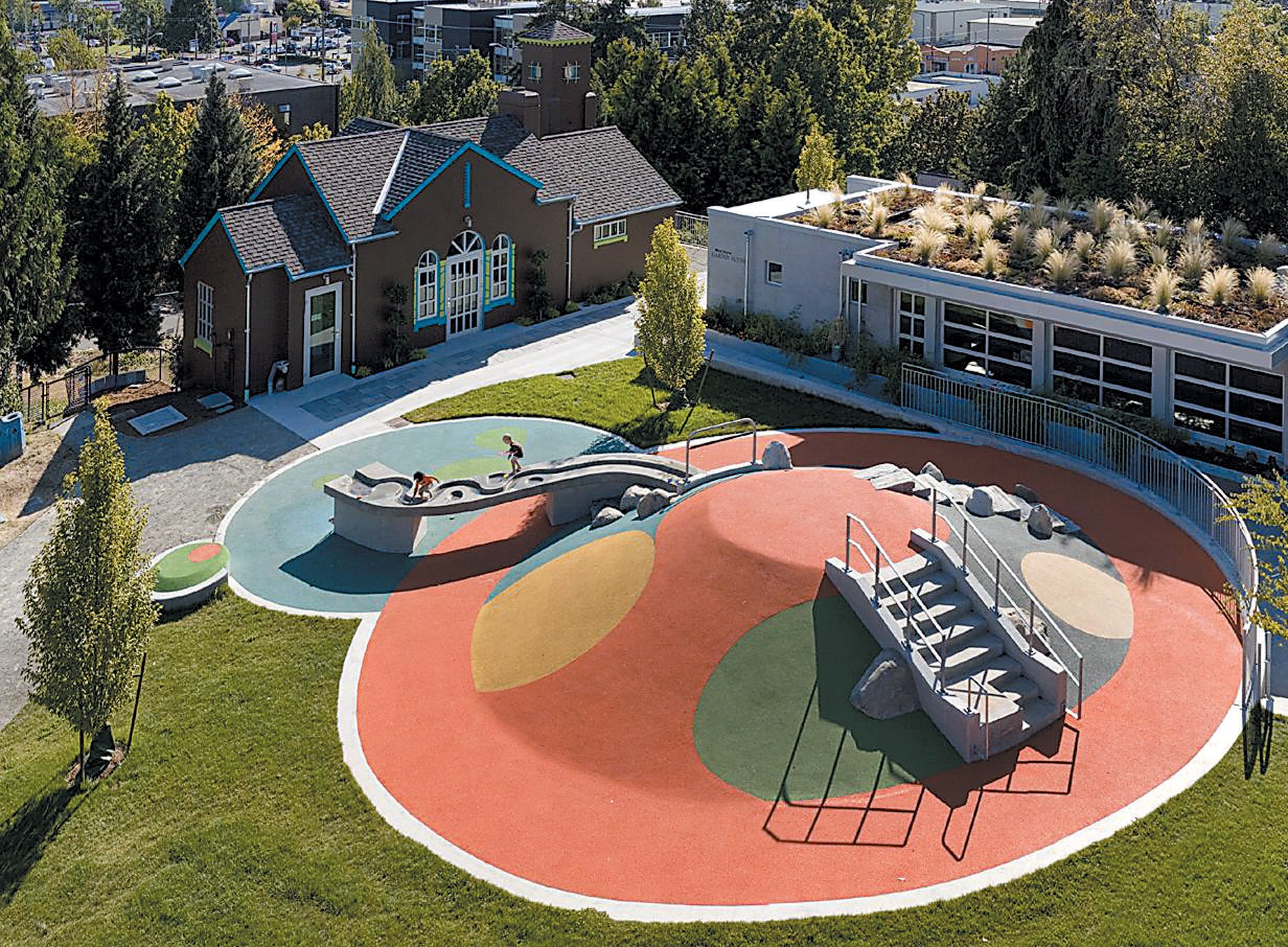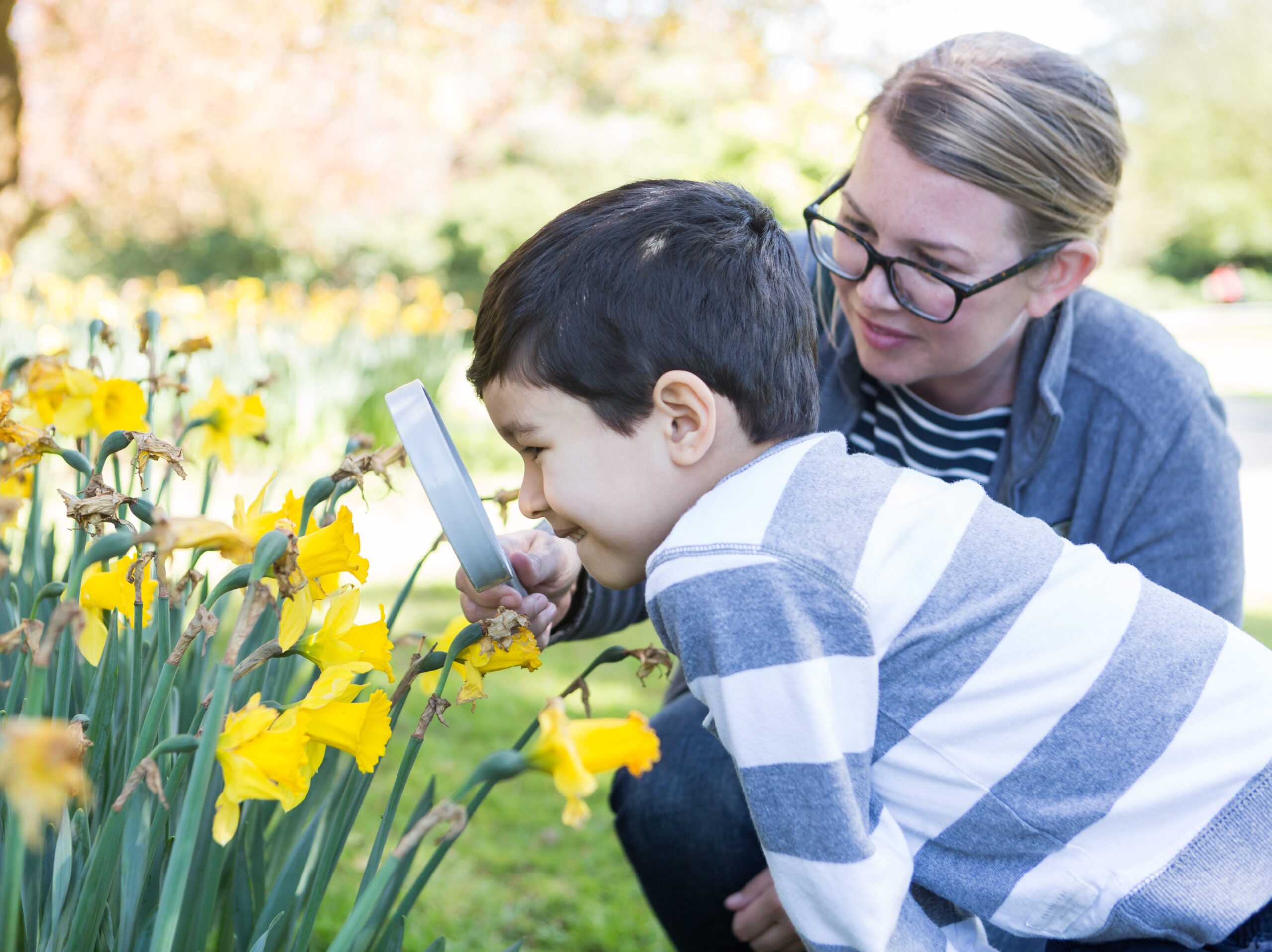

Contributor
- Topics: Archive

Imagine a public park in your city or town that includes elegantly housed chickens and bunnies, accessible climbing structures for children of all ages, giant topiary animals, and a kitchen garden planted with all sorts of yummy vegetables children love—peas, beets, corn, lettuce, potatoes—that are then cooked up, on the spot, in a child-friendly kitchen. Yes, that’s right—all of this in a public park!
Seattle is fortunate to have such a remarkable play space, and it has been designed for everyone: kids on two feet, kids with walkers, kids in wheelchairs, kids who communicate differently. Digging in the dirt, swinging in the sun, chasing butterflies: all children deserve these simple pleasures.
As Liz Bullard, executive director of the Seattle Children’s PlayGarden explains, “Children with special needs have a right to play alongside their typically developing siblings and friends.” The PlayGarden strives to provide “them with full access to a safe indoor/outdoor recreation space” and to offer “inclusive programs that encourage their potential.”
In February 2002, Bullard, a speech pathologist at Seattle’s Boyer Children’s Clinic, happened upon a short article about Manhattan’s Rusk Children’s Garden, which was designed for children with special needs. Inspired to find a similar place in the Northwest, where children of all abilities could come to play together, she confidently began her search.
Finding a Place to Play

She knew the children who needed such a play space well. As Bullard explains,
“. . . for almost twenty years, I had worked with hundreds of children with challenges such as autism, cerebral palsy, and hearing or vision impairments. I watched as these children and their parents worked day-by-day to help their children succeed. Days are filled with therapy appointments—physical therapy, occupational therapy, speech therapy, doctor’s appointments, school, and tutoring. They have an intense schedule that we adults would buckle under. But, when school is finally out, where can these hard-working kids go to play?”
Bullard’s search produced no such play space in the Northwest. As she remembers,
“When my kids were little, we went to the park every day. And we had choices. We could go to the ride-your-bike park, the woods park, or the beach park. My kids could scramble up the climber, hop on a swing, or race around the park on their scooters.”
But children with cerebral palsy cannot access play equipment, even if the park itself is accessible. Children with autism don’t heed common dangers, and parks are not fenced. Parents of children with special needs often leave an outing in a park discouraged and exhausted. What was pure pleasure for Bullard’s typical kids could be a nightmare for families of children with special needs. But Bullard believed that “Seattle is too great a city not to have a park for children with challenges.”


Creating Play Space for All
So she emailed everyone she knew who might have ideas about how to address this basic inequity. Others joined her efforts, and Dr Abe Bergman agreed to chair the board of a non-profit organization dedicated to fulfilling Bullard’s vision of a Children’s PlayGarden.
As Bullard recalls,
“We imagined a place where children of all abilities could come and play—simply play, outdoors, with their friends and siblings. The landscape would be challenging but accessible. Staff would be on hand to assist parents and children so that everyone could participate. Therapy would be happening, and children wouldn’t even realize it.”
Wagons full of soil would strengthen muscles, tending a garden would enhance coordination, and climbing a play mound would improve balance. Setting up a farm stand would strengthen social and language skills—all outdoors, with typical kids together with children with challenges. “Friendships and independence would be fostered, and understanding and empathy would be a natural byproduct.”
The time was right. Then superintendent of Seattle Parks and Recreation Ken Bounds loved the idea and agreed that Parks and Recreation simply did not have the resources to serve these families as it should. He set about finding a piece of land for the PlayGarden; that land is now the first such play space located in a public park in the entire country.

A Dream Realized
In June 2010, after a five-year capital campaign, the PlayGarden opened its beautiful Garden House. Along with the original (now renovated) Parks and Recreation field house, a fully accessible play mound that includes a lazy water feature, a stunning butterfly garden, a chicken coop and rabbit hutch, and an ever-changing vegetable garden, the Garden House provides space for creative cooking projects, water play, art and earth-moving, work and friendship.
Bullard remembers 2006, when the Play Garden offered its first summer program in an almost-empty park:
“It was clear from the start that the need was great. Children came from all over the greater Seattle area—from Renton, Woodinville, even Monroe. There simply are not fully inclusive programs available for children of all abilities.”
The day before that first summer program was to start, as Bullard was puttering about, putting the finishing touches on the vegetable garden, she looked up to see a woman in a motorized wheel chair heading her way. On the back of her wheelchair was a little boy. The woman stopped, curious about what was happening in her neighborhood park. When Bullard explained what was going on, tears came to the woman’s eyes. Bullard recalls,
“She went on to explain that her son was an active little boy. They lived in a small apartment with no outdoor play space. Even worse, he had just been kicked out of his preschool program because he was too hard to handle. She had grown up on a farm and knew how important it was to play outside. It broke her heart that she could not provide outdoor play space for her son. So I assured her that, if she brought Milton back the next day, he would be tired, dirty, and happy when she came to pick him up.”
Milton has spent every summer since 2006 at the PlayGarden. He has grown up. He takes care of the garden on off-days. He knows how to plant and mulch. He is comfortable with the chickens and bunnies. He is now in the fifth grade and is doing well in school and life. As Bullard summarizes, “He ‘owns’ the PlayGarden!”
Why Not More?
Many, many professionals and volunteers contributed to the creation of the Seattle Children’s PlayGarden. It would not exist without the vision of Liz Bullard and the commitment of her hard-working board. But it would also not exist without the creativity of architects and landscape architects, garden designers, child therapists, and the children themselves. It is the result of a public-private collaboration; great need; many financial contributions from individuals, foundations and corporations; and hundreds of believers to spread the word. It makes Seattle a better city.
Currently, the PlayGarden’s summer camps serve 500 children from all over the Seattle metropolitan area. There is a teen camp; a weekly, facilitated parent- child group for children ages one to four; eight free summer-play dates scheduled throughout the summer; and expanding preschool programs for children from the neighborhood and beyond. The Seattle Children’s PlayGarden will forever be a work-in-progress, always responding to the needs of the community and its important child visitors.
It may even inspire other communities to create such resources.
The Importance of Play

Almost thirty percent of all children have special needs; they include a broad range of physical, cognitive, and psychological conditions that can be expected to last at least a year. A small group of these children have life-long conditions.
Increasingly, it is recognized that, although most children follow a pattern of typical development, almost every child will continue to develop at his or her own pace. Since children learn best through exploration and experience, play is essential to the development of all children.
The developmental stages of play include, first, solitary play. Gradually, a child playing independently becomes more curious about those playing nearby, and play becomes more parallel, sometimes even cooperative. Finally, children learn to play collaboratively. They don’t learn these skills by watching children play on television; they learn by actively exploring the world with others.
Play is essential, too, for developing personal sensory and physical skills—at whatever pace is appropriate for each child. Through play, children learn to integrate muscle and cognitive skills with their sensory and physical skills. Perhaps more important, play teaches children what it means to have friends, to take turns, and to be patient. Then there is the joy of accomplishing something—the pride that comes from helping carrots grow, climbing higher, or learning to make hummus.
Successful play experiences are supervised in ways that help children meet their needs and their personal goals. Successful play areas need to be designed to encourage independent and solitary play as well as cooperative play, and to accommodate all children, regardless of the pace of their development. The staff of Seattle Children’s PlayGarden makes sure that there are myriad opportunities for explor-ation and for each child to feel proud of his or her accomplishments.
Our goal as a society should be to help every individual reach his or her maximum potential. Thoughtfully designed playgrounds are essential links in reaching this goal.
John M & Lee Neff

If You Should Like to Visit
The Seattle Children’s PlayGarden is located at 1745 24th Avenue S, Seattle, WA 98144. Please visit the PlayGarden website at www.childrensplaygarden. org. Call Liz Bullard at 206/227-5458 to see how you can volunteer to help with the programs at the PlayGarden, or find out how to build a similar project in your community. Come for a visit, and don’t hesitate to bring your children!
Share:
Social Media
Garden Futurist Podcast
Most Popular
Videos
Topics
Related Posts

Ground Up Science for Greener Cities with Garden Futurist Dr. Alessandro Ossola
Spring 2023 Listen to the Podcast here. Alessandro Ossola is a scientist who gets very excited about the challenge of climate change allowing for an

Readying Urban Forests for Climate Realities with Garden Futurist Dr. Greg McPherson
Winter 2023 Listen to the Podcast here. “Going from the mow and blow to a more horticulturally knowledgeable approach to maintaining the landscape. And that

January Showers Bring February flowers…
Fall 2022 It may not quite have the same ring to it as the old English proverb, but it has a lot more truth to

Low Maintenance Gardens – Better for Pollinators and People
Autumn 2022 “I come out every day. It’s therapy, my meditation.” Janet’s young garden transformed from overgrown, invasive plants to mostly natives. The dailiness of








Responses